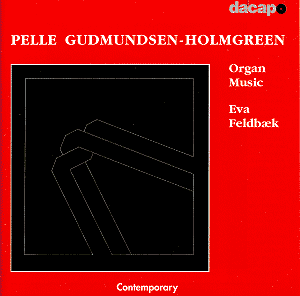Pelle Gudmundsen-Holmgreen’s music is highly esteemed
in Denmark. There is also nowadays a growing interest abroad. He
has described his work as ‘a kind of pot-luck music which of course
reflects both his European and Danish identity, but also leaves
room for American impulses’. He also has interest in visual arts
that is reflected directly in his works.
His early influences stretching back to the 1950s
were the Danish post-Nielsen Neoclassicism, Bartók and
Stravinsky. By 1960 his work turned up at the ISCM festival in
Cologne. There it was perceived as being open ‘to overwhelming
impressions from the central European avant-garde, above all the
leading figures of serialism, Boulez and Stockhausen - and not
least to Ligeti’s new views of sonority’. He was influenced by
the American visual artist Robert Rauschenberg and he attempted
‘to create object-like sounds or elements and let them meet one
another’.
Gudmundsen-Holmgreen was one of the main figures
of the ‘New Simplicity’ movement in the mid-sixties with concretism
and stylistic pluralism as some of the characteristic elements.
During the 1970s he made use of the so-called
‘filter’, which is ‘a certain selection of notes in the form of
a self-reflecting tonal grid which leads to a symmetrical structure,
including frequent mirrorings’.
His organ music falls into three periods. Mirror
III from 1974, Octapus from 1987 and new works from 1999 onwards.
In all these works he chooses ‘with great assurance which features
of the organ he wants to single out to create his musical universe.
The music is thus inextricably linked with the nature of the instrument’.
In general his music combines the grotesque, the comic and the
abstract together with an improvisatory feeling.
In Mirror III the melodies and harmonies ‘are
symmetrical around a middle note, and rhythms are mirrored around
a central axis’. Still/Leben, Countermove and In triplum make
a series of eight pieces very different from each other combining
polyrhythm, polychromaticism, diatonics and melody. Der er så
favrt I Jelling at hvile (Fair it is to rest in Jelling) was written
for ‘the transfer of the bones of King Gorm the Old to Jelling
church. The music is based on old familiar Danish material. Arkaisk
Procession combines four different melodies at the same time whereas
the Spejlkabinet uses an ‘extra dimension to the music by means
of the glissando of the reed stops, and perhaps also the very
idea of music that is played both on the organ and inside the
organ’. This is a very abstract but well formed piece.
It is quite hard to gain a fair account of this
music without listening to it many times. Actually the more you
listen to it, the more you feel familiar with all these effects
that the organ can produce. For the organ listener this is not
music that is likely to instantly attract. Ultimately however
it is the originality that commands attention.
Eva Feldbæk and her assistants perform
superbly and capture extremely well the original spirit of the
music.
Christina Antoniadou

